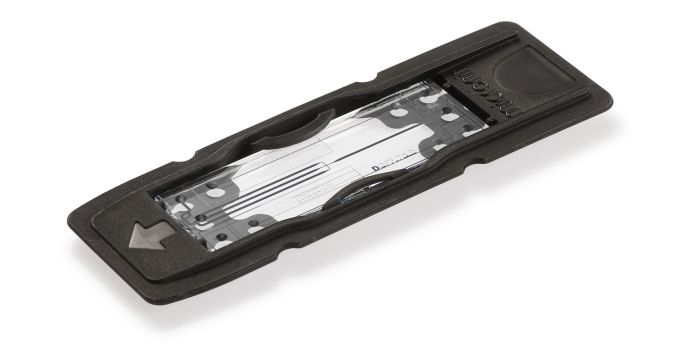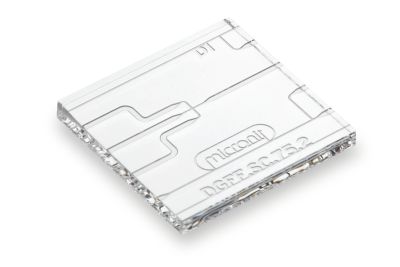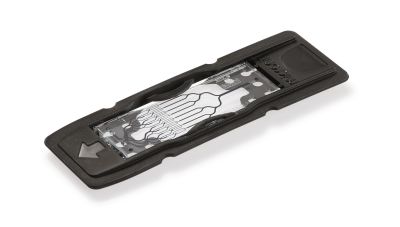shopping_basket
Focused Flow Droplet Generator - Topconnect
SKU
FF_DROP_TOP_CONFIG
Availability:
check_circle In stock
As low as $660.28
per pack of 3
Pack of 3 focused flow droplet generators for use in combination with our Fluidic Connect Pro chip holder. The chips are available with a hydrophobic coated or an uncoated (hydrophilic) channel surface.
Recommended reference droplet size ranges per nozzle type:
10µm nozzle: 9-20µm
20µm nozzle: 20-40µm
50µm nozzle: 40-90µm
75µm nozzle: 65-140µm
The reference droplet size range is based on a reference experiment with Silicone oil 5cSt and DI water combined with 2% v/v Tween 20 or Tween 80.
Pack of 3 single nozzle droplet generators with a nozzle etched on both sides, giving the following advantages:
- Optimized nozzle geometry
- Symmetric channels and nozzles for uniform droplet formation
- Droplet production stable over a broader size and frequency range
- Smaller droplet sizes available
This microfluidic droplet generator is an excellent tool for generating highly reproducible microsized droplets with much higher precision and repeatability compared to conventional methods.
By tuning the relative viscosities, surface tension, and velocities between the dispersed and the continuous phase, droplet size and frequency can be altered. Oil-in-Water (O/W) droplets can be generated directly using the glass chips. Also, these droplet generators are suitable for coating in order to form Water-in-Oil droplets (W/O).
Further specifics:
- Droplet size can roughly be tuned from the size of the nozzle to be doubled
- Suitable for foam, digital PCR, single cell analysis, emulsions etc.
- Made from high quality glass, borosilicate, suitable for most biological and chemical applications
Application examples:
Cell, DNA, bead encapsulation for
- drug discovery
- drug studies
- molecular biological studies
- immunology studies
- evolutional studies
- enzyme catalysis studies
Food, paints, foams
- Bubble formation
- Mineral Oil Emulsion Production
- Particle production - PLGA, PEGDA, gelatine, alginate, polystyrene, agaros
- Drug delivery - creams, aerosols
Chemical
- Droplet based micromixing
- Droplet based microreactions
| Unit of measurement | pack of 3 |
|---|---|
| Interface type | Topconnect |
| Chip material | Borosilicate glass |
| Supply format & dimensions | Supplied in a black polymer cardtridge with an external dimension of 75 x 25mm. |
| Chip thickness | 1800µm |
| Channel location | Depending on selection |
| Number of inlets | 2 |
| Number of outlets | 1 |
| Icon | Label | Description | Type | Size | Download |
|---|---|---|---|---|---|
 | DGFF.10 - Drawing | Drawing for 10µm Topconnect Focused Flow Droplet Generator. Items 01341 and 00935. | 159.2 KB | Download | |
 | DGFF.50 - Drawing | Drawing for 50µm Topconnect Focused Flow Droplet Generator. Items 01366 and 00877. | 179.6 KB | Download | |
 | DGFF.75 - Drawing | Drawing for 75µm Topconnect Focused Flow Droplet Generator. Items 00970 and 00580. | 193.6 KB | Download | |
 | Surface wetting properties | 220.3 KB | Download | ||
 | Flow rate instructions | 303.6 KB | Download | ||
 | How to prevent clogging | 153 KB | Download | ||
 | Using the right surfactants | 168.8 KB | Download | ||
 | Droplet Generator Guide | 617 KB | Download |
Customer Questions
We found other products you might like!
- Droplet generation setup - topconnect (no pumps included)
From $2,132.84
To $12,779.65




![Focused flow droplet generator - nozzle 10 µm - with 175 µm bottom [Limited Edition]](https://micronit.com/media/catalog/product/cache/459fbc7fb24a7869aeeabc813397f516/d/g/dgff_10_7_2_3.jpg)
